Validation of UWG and ENVI-Met Models in an Abu Dhabi District, Based on Site Measurements
Abstract
1. Introduction
- (a)
- To make a seasonal validation of the UWG for the city of Abu Dhabi. The UWG has been partially validated for the city of Abu Dhabi (no seasonal study), for the city of Singapore and previously for the cities of Toulouse, Basel, Rome and Barcelona [24,25,26]. The accuracy and the calculation method has been recently improved [24]. It can be used to estimate the UHI effect and building energy consumption at a neighbourhood scale considering the green area, the density of the buildings, etc.
- (b)
- To make a seasonal validation of ENVI-met 4.0 for the city of Abu Dhabi. Previous validation for such a climate has not been conducted. Considering the usage of such a tool by architects and urban planners the results of this study has a relevance to the region. The models are prepared based on realistic data from the material collected and from the site survey. The accuracy of the models, and boundary conditions, bring results close to the site data. The results are compared with the version 3.1 and the site measurements.
- (c)
- To estimate the impact of the anthropogenic heat into the air temperature and correct the results of the ENVI-met accordingly. This correction is also relevant for the calculation of the PET (Physiological Equivalent Temperature), where ENVI-met is massively used (as a post-process of the air temperature calculation, the increase of the anthropogenic heat has an impact on the increase of the UHI [25]).
2. Methodology
- 2.1. The case study,
- 2.2. The rural data,
- 2.3. The urban data,
- 2.4. Urban Weather Generator file creation/simulations,
- 2.5. ENVI-met model creation/simulations,
2.1. The Case Study
2.2. The Rural Data
2.3. The Urban Data
2.4. The Urban Weather Generator
2.5. ENVI-Met Models
3. Results
4. Conclusions and Future Work
Author Contributions
Funding
Acknowledgments
Conflicts of Interest
Appendix A
References
- Böer, B. An introduction to the climate of the United Arab Emirates. J. Arid Environ. 1997, 35, 3–16. [Google Scholar] [CrossRef]
- Afshari, A.; Schuch, F.; Marpu, P. Estimation of the traffic related anthropogenic heat release using BTEX measurements—A case study in Abu Dhabi. Urban Clim. 2017, 24, 311–325. [Google Scholar] [CrossRef]
- Santamouris, M. Cooling the cities—A review of reflective and green roof mitigation technologies to fight heat island and improve comfort in urban environments. Sol. Energy 2014, 103, 682–703. [Google Scholar] [CrossRef]
- Khan, S.M.; Simpson, R.W. Simulation of mixing depths incorporating the urban heat island effect. Environ. Model. Assess. 2001, 6, 183–193. [Google Scholar] [CrossRef]
- Sailor, D.J. A review of methods for estimating anthropogenic heat and moisture emissions in the urban environment. Int. J. Climatol. 2011, 31, 189–199. [Google Scholar] [CrossRef]
- Taha, H. Urban climates and heat islands: Albedo, evapotranspiration, and anthropogenic heat. Energy Build. 1997, 25, 99–103. [Google Scholar] [CrossRef]
- Available online: https://www.ncm.ae/en#!/Radar_Merge_Sat/26 (accessed on 12 August 2019).
- Thomas, A.E.; Elizabeth, A. Sustainable Landscapes for Residential Neighborhoods in Dubai: An Analysis of the Relationship between Ambient Temperature and Water Requirements of Landscape; Dubai University: Dubai, UAE, 2013. [Google Scholar]
- The Man behind Abu Dhabi’s Master Plan | The National. Available online: http://www.thenational.ae/uae/heritage/the-man-behind-abu-dhabis-master-plan (accessed on 13 December 2016).
- Oke, T.R.; Maxwell, G.B. Urban heat island dynamics in Montreal and Vancouver. Atmos. Environ. 1975, 9, 191–200. [Google Scholar] [CrossRef]
- Unzeta, B.B.; Norford, L.K.; Britter, R. An Urban Weather Generator Coupling Building Simulations with a Physically Based Urban Model. In Proceedings of the 7th Internation Conference on Urban Climate (ICUC-7), Yokohama, Japan, 29 June–3 July 2009. [Google Scholar]
- Bueno, B.; Hidalgo, J.; Pigeon, G.; Norford, L.; Masson, V. Calculation of Air Temperatures above the Urban Canopy Layer from Measurements at a Rural Operational Weather Station. J. Appl. Meteorol. Climatol. 2013, 52, 472–483. [Google Scholar] [CrossRef]
- Oke, T.R. Boundary Layer Climates; Routledge: London, UK, 1987. [Google Scholar]
- Chow, W.T.L.; Roth, M. Temporal dynamics of the urban heat island of Singapore. Int. J. Climatol. 2006, 26, 2243–2260. [Google Scholar] [CrossRef]
- Huttner, S.; Bruse, M.; Dostal, P. Full 3D Editor Numeriacl Modelling of the Urban Microclimate—A Preview on ENVI-MET 4.0; The seventh Internation Conference on Urban Climate: Yokohama, Japan, 2009. [Google Scholar]
- Acero, J.A.; Arrizabalaga, J. Evaluating the performance of ENVI-met model in diurnal cycles for different meteorological conditions. Theor. Appl. Climatol. 2016, 131, 1–15. [Google Scholar] [CrossRef]
- Bruse, M. Simulating Microscale Climate Interactions in Complex Terrain with a High-Resolution Numerical Model: A Case Study for the Sydney CBD Area (Model Description). Available online: http://www.envi-met.net/documents/papers/CBDSimu1999.PDF (accessed on 10 February 2019).
- Oke, T.R. Canyon geometry and the nocturnal urban heat island: Comparison of scale model and field observations. J. Climatol. 1981, 1, 237–254. [Google Scholar] [CrossRef]
- Giridharan, R.; Lau, S.S.Y.; Ganesan, S.; Givoni, B. Lowering the outdoor temperature in high-rise high-density residential developments of coastal Hong Kong: The vegetation influence. Build. Environ. 2008, 43, 1583–1595. [Google Scholar] [CrossRef]
- Stewart, I.D. A systematic review and scientific critique of methodology in modern urban heat island literature. Int. J. Climatol. 2011, 31, 200–217. [Google Scholar] [CrossRef]
- Hamdi, R.; Schayes, G. Sensitivity study of the urban heat island intensity to urban characteristics. Int. J. Climatol. 2008, 28, 973–982. [Google Scholar] [CrossRef]
- Abu Dhabi Urban Planning Council—Abu Dhabi Vision 2030. Available online: http://www.upc.gov.ae/abu-dhabi-2030.aspx?lang=en-US (accessed on 1 February 2017).
- Estidama. Available online: http://estidama.upc.gov.ae/ (accessed on 10 July 2019).
- Bueno, B.; Roth, M.; Norford, L.; Li, R. Computationally efficient prediction of canopy level urban air temperature at the neighbourhood scale. Urban Clim. 2014, 9, 35–53. [Google Scholar] [CrossRef]
- The Man behind Abu Dhabi’s Master Plan | The National. Available online: http://www.thenational.ae/uae/heritage/the-man-behind-abu-dhabis-master-plan#page3 (accessed on 10 June 2018).
- Bruse, M.; Fleer, H. Simulating surface–plant–air interactions inside urban environments with a three dimensional numerical model. Environ. Model. Softw. 1998, 13, 373–384. [Google Scholar] [CrossRef]
- Ministry of Environment and Water of UAE. UAE State of Green Economy 2014; Ministry of Environment and Water of UAE: Abu Dhabi, UAE, 2014.
- Paolini, R.; Mainini, A.G.; Poli, T.; Vercesi, L. Assessment of Thermal Stress in a Street Canyon in Pedestrian Area with or without Canopy Shading. Energy Procedia 2014, 48, 1570–1575. [Google Scholar] [CrossRef]
- Mao, J.; Yang, J.H.; Afshari, A.; Norford, L.K. Global sensitivity analysis of an urban microclimate system under uncertainty: Design and case study. Build. Environ. 2017, 124, 153–170. [Google Scholar] [CrossRef]
- Cassano, S.; Francisco, C.; Ganglani, P.M.; Sathish, A.; Pinto, Z. Atlas Environmentla of Abu Dhabi Emirates; Environmental Agency: Abu Dhabi, UAE, 2011.
- Oke, T.R. Initial guidance to obtain representative meteorological observations at urban sites. World Meteorol. Organ. 2004, 81, 51. [Google Scholar]
- Toppi, T.; Zangheri, P.; Paolini, R. Simplified Method for Modification of Weather Data File for Energy Simulations within Urban Areas; Politecnico di Milano: Milan, Italy, 2009. [Google Scholar]
- Lindita, B. Heat Island Mitigation Strategies, with Focus on the Urban Shading Devices. The Case Study of Abu Dhabi Main Island, United Arab Emirates; Politecnico di Milano: Milan, Italy, 2017. [Google Scholar]
- Bande, L.; Cabrera, A.G.; Afshari, A.; Martin, M. Evaluation of Smart Shading Structures in Mitigating Urban Heat Island in a District of a Hot Arid Climate City (Abu Dhabi). In Proceedings of the 9th Internation Conference on Urban Climate (ICUC-9), Toulouse, France, 20–24 July 2015. [Google Scholar]
- Karakounos, I.; Dimoudi, A.; Zoras, S. The influence of bioclimatic urban redevelopment on outdoor thermal comfort. Energy Build. 2018, 158, 1266–1274. [Google Scholar] [CrossRef]
- Roth, M.; Lim, V.H. Evaluation of canopy-layer air and mean radiant temperature simulations by a microclimate model over a tropical residential neighbourhood. Build. Environ. 2017, 112, 177–189. [Google Scholar] [CrossRef]
- d’Argent, N.M.J. A Microclimatic and Bioclimatic Modelling Assessment of the Compact City Morphology; a Case Study of Melbourne@ 5 Million; Monash University: Melbourne, Australia, 2012. [Google Scholar]
- Home | Envimet. Available online: http://www.envi-met.com/ (accessed on 10 June 2018).
- Roth, M.; Jansson, C.; Velasco, E. Multi-year energy balance and carbon dioxide fluxes over a residential neighbourhood in a tropical city. Int. J. Climatol. 2016, 37, 2679–2698. [Google Scholar] [CrossRef]
- Carfan, A.C.; Galvani, E.; Nery, J.T. Study of thermal comfort in the City of São Paulo using ENVI-met model Estudio del confort térmico en la ciudad de São Paulo utilizando el modelo ENVI-MET. Núm 2012, 78, 188–4611. [Google Scholar]
- Yaghoobian, N.; Kleissl, J. Effect of reflective pavements on building energy use. Urban Clim. 2012, 2, 25–42. [Google Scholar] [CrossRef]
- Ozkeresteci, I.; Crewe, K.; Brazel, A.J.; Bruse, M. Use and evaluation of the ENVI-met model for environmental design and planning. An Experiment on Lienar Parks. In Proceedings of the 21st International Cartographic Conference (ICC), Durban, South Africa, 10–16 August 2003; pp. 10–16. [Google Scholar]
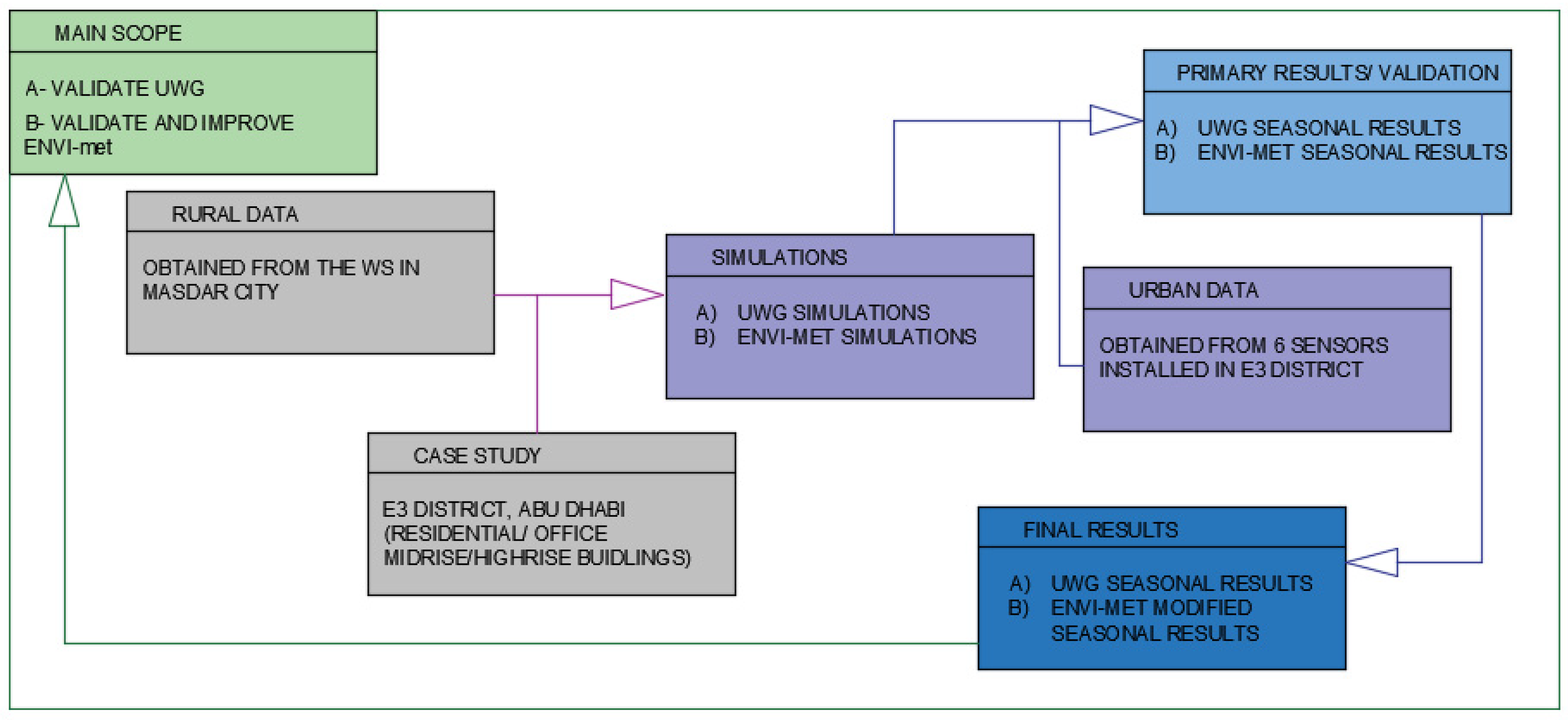

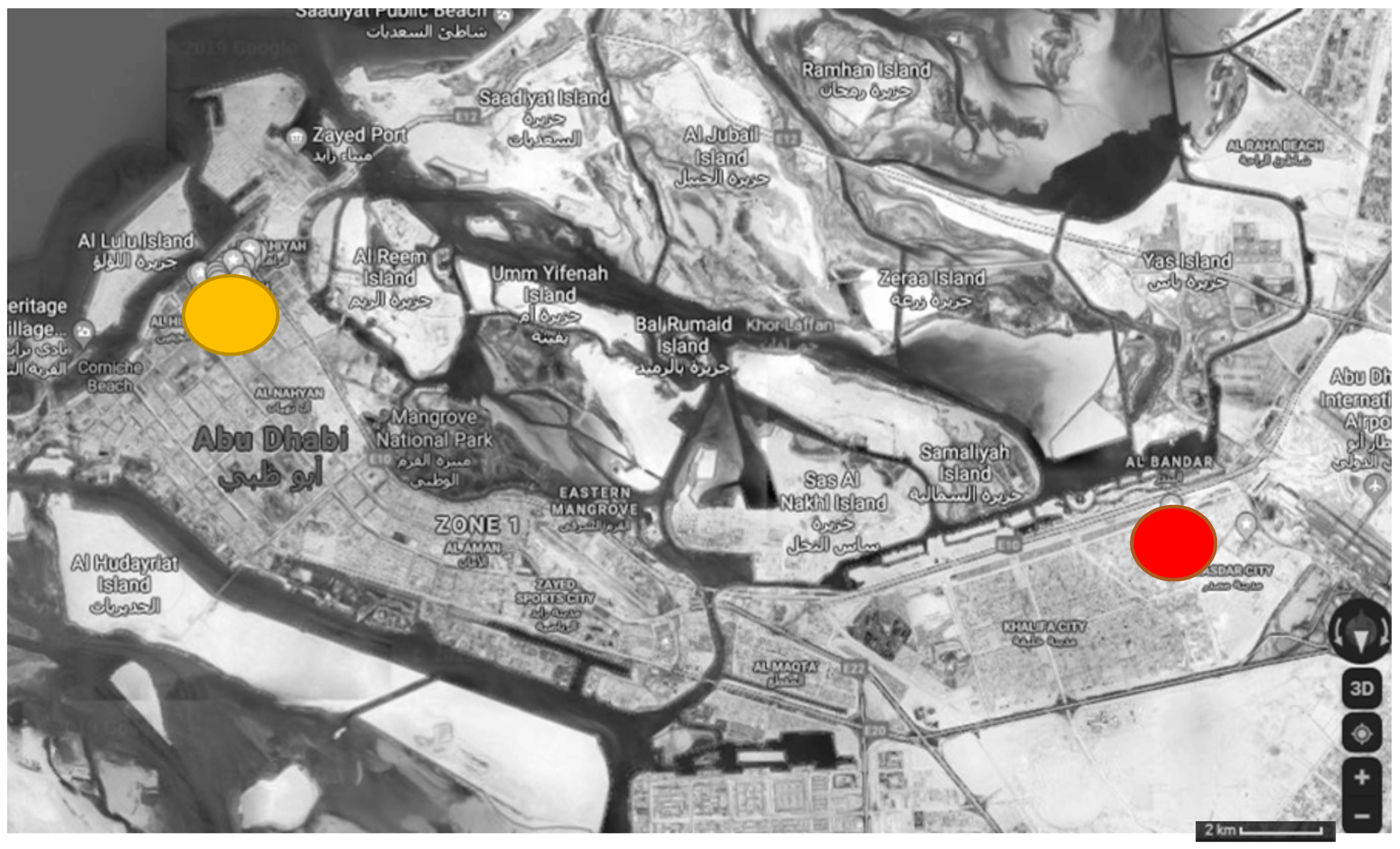
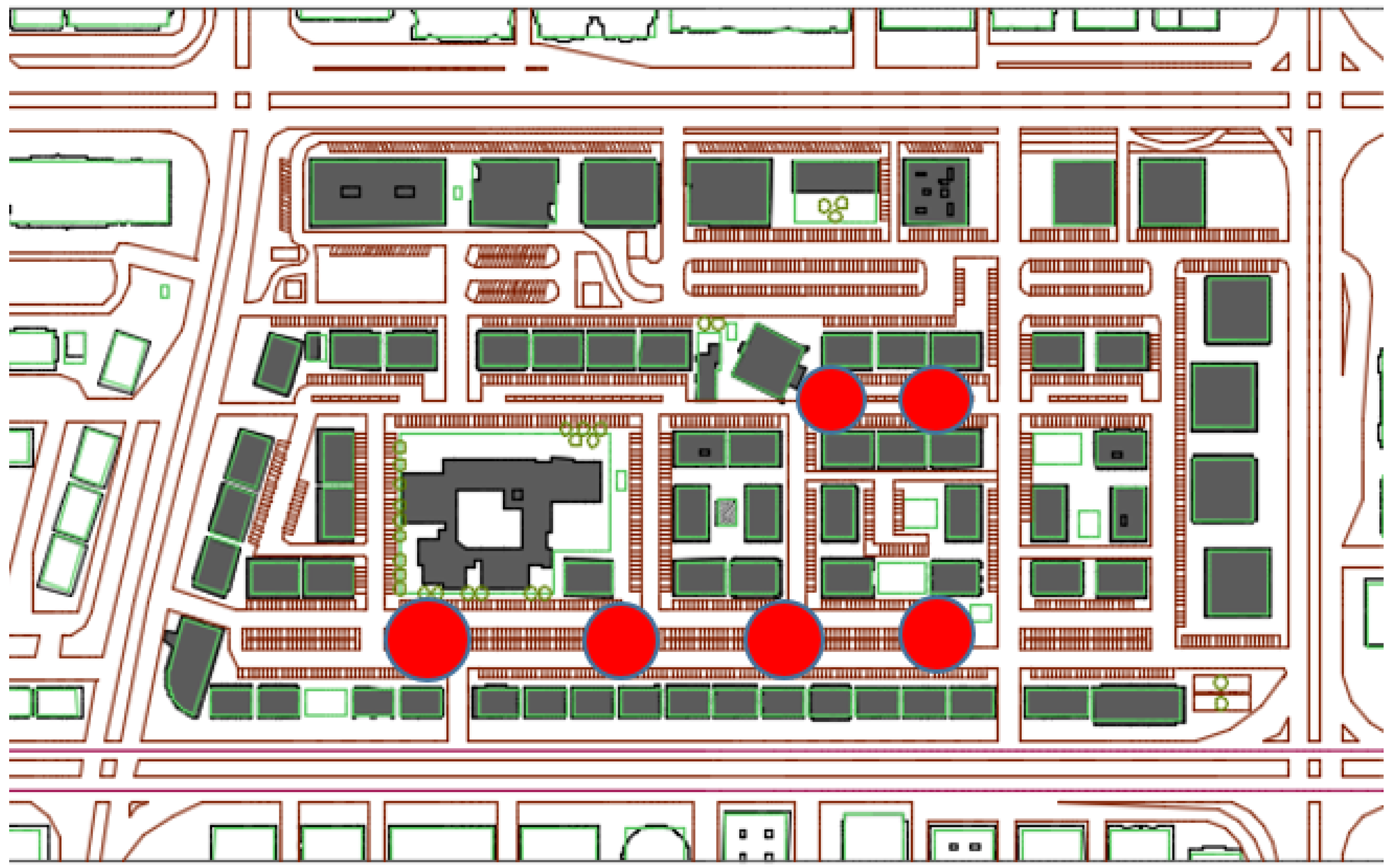

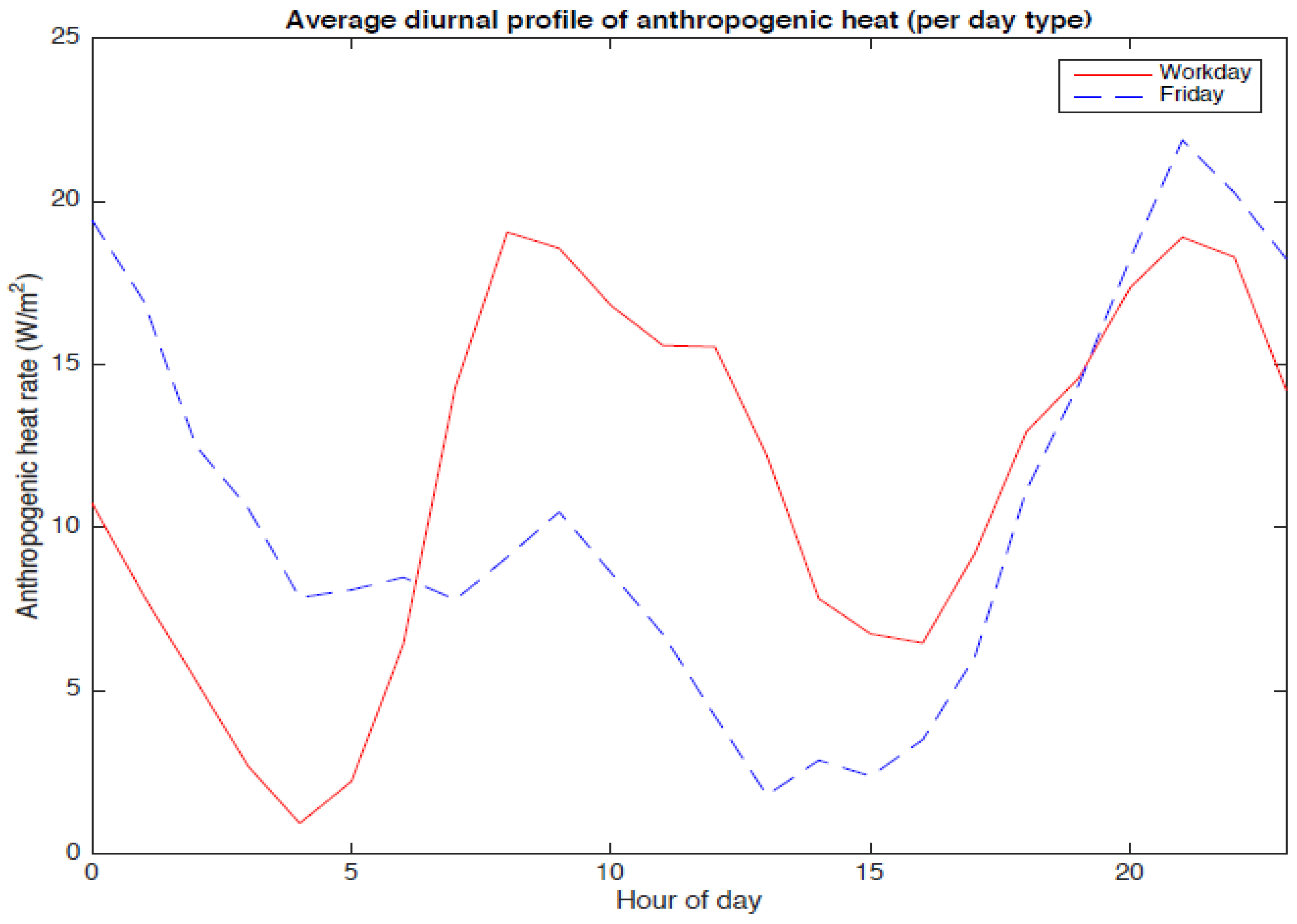
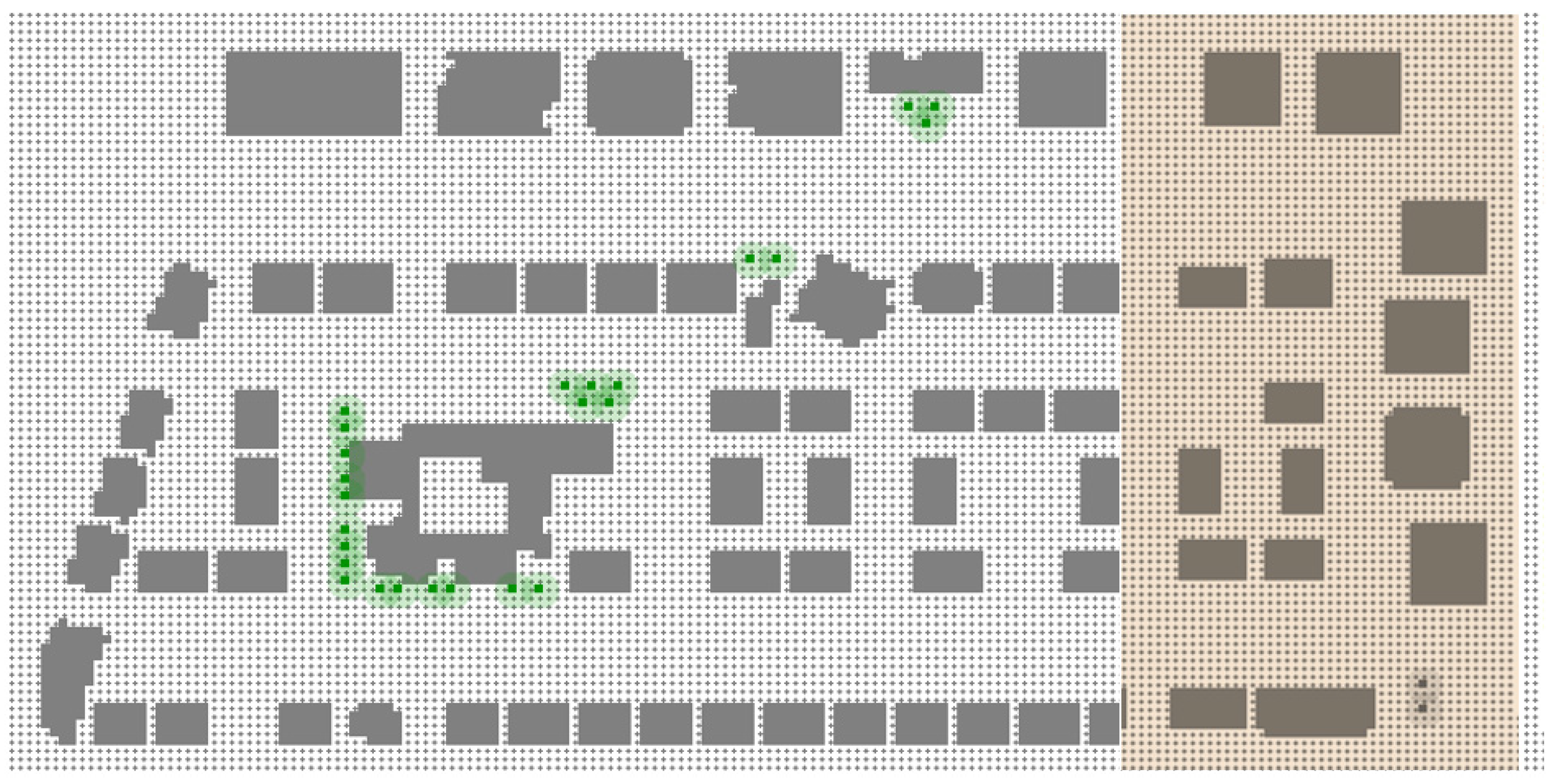
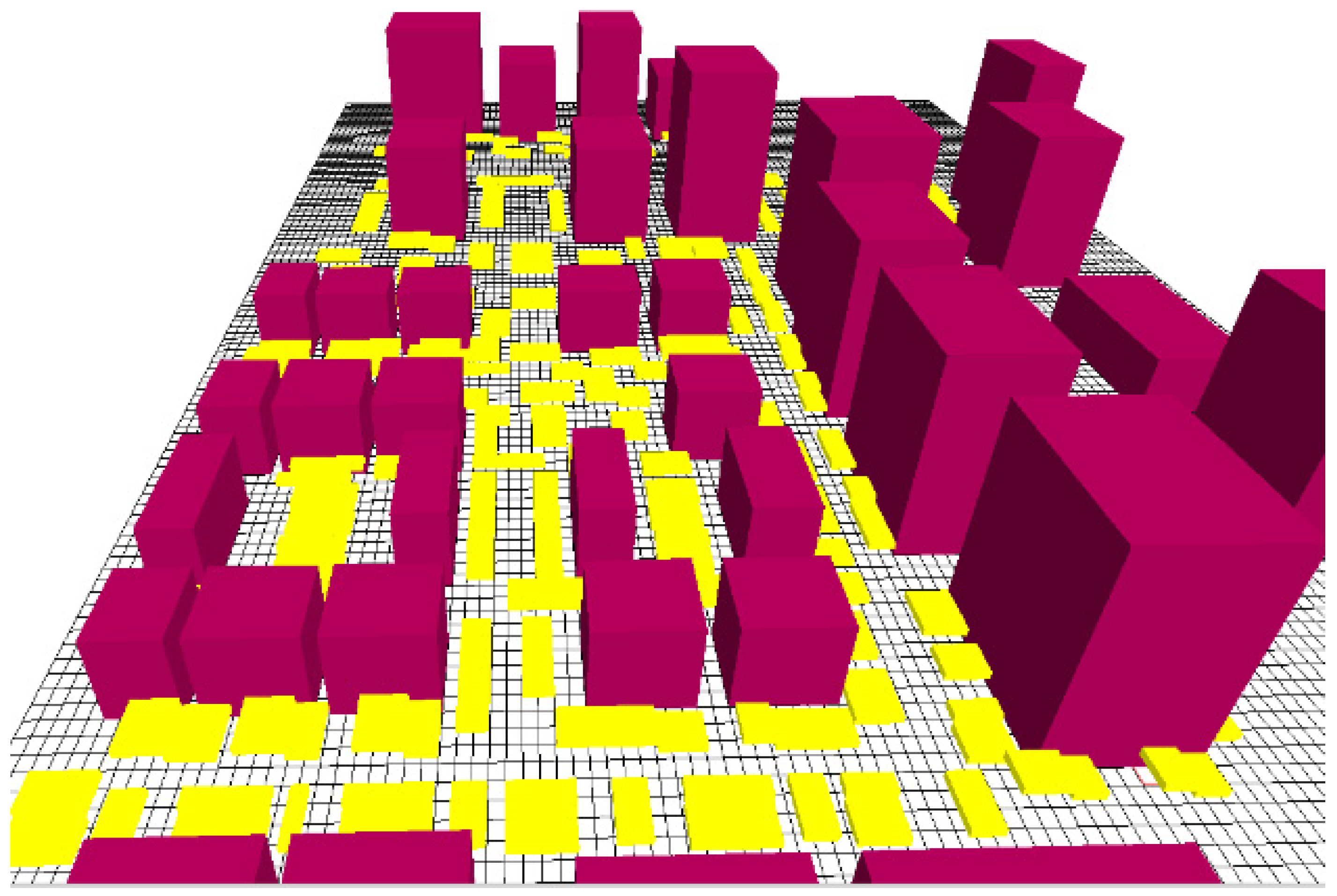
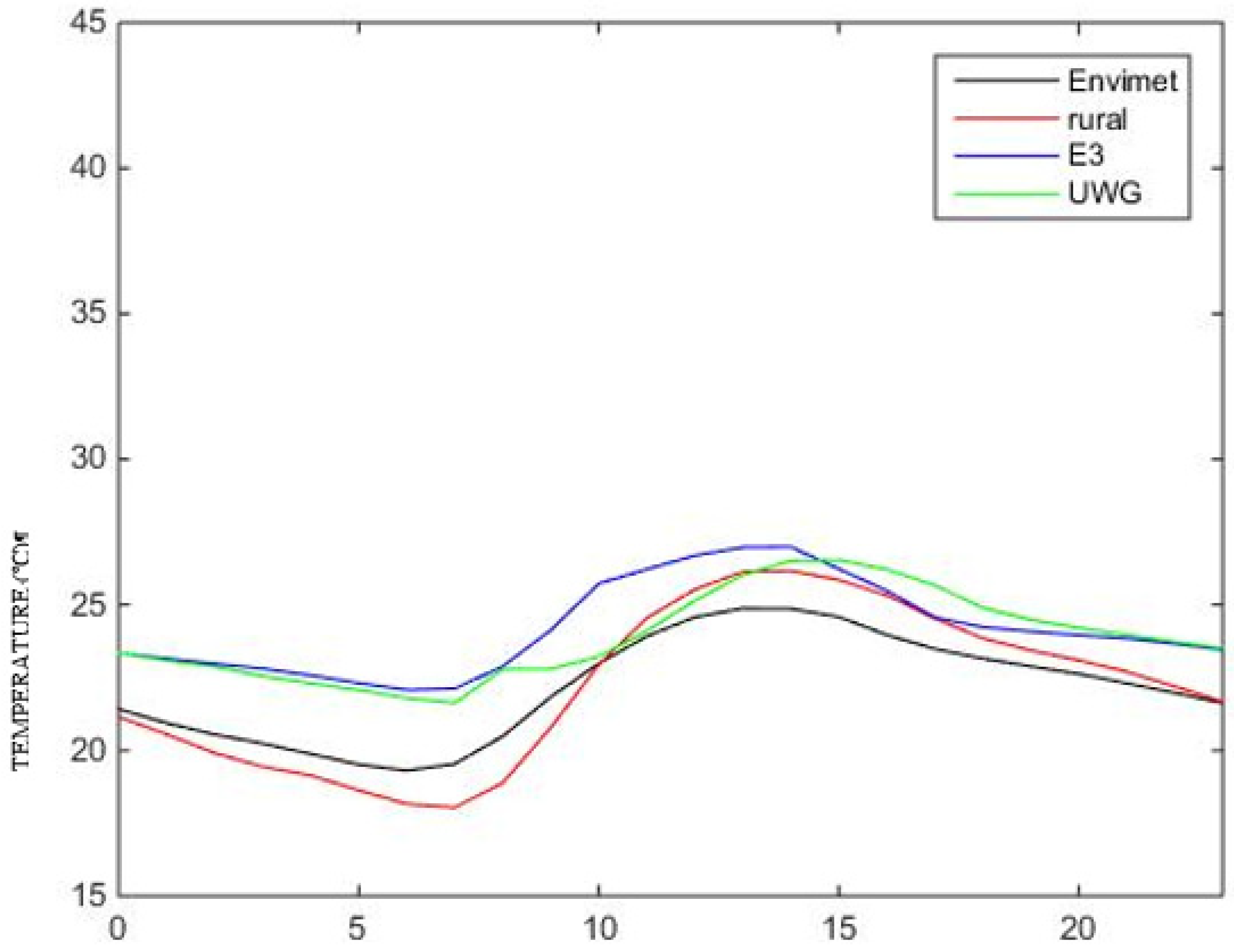
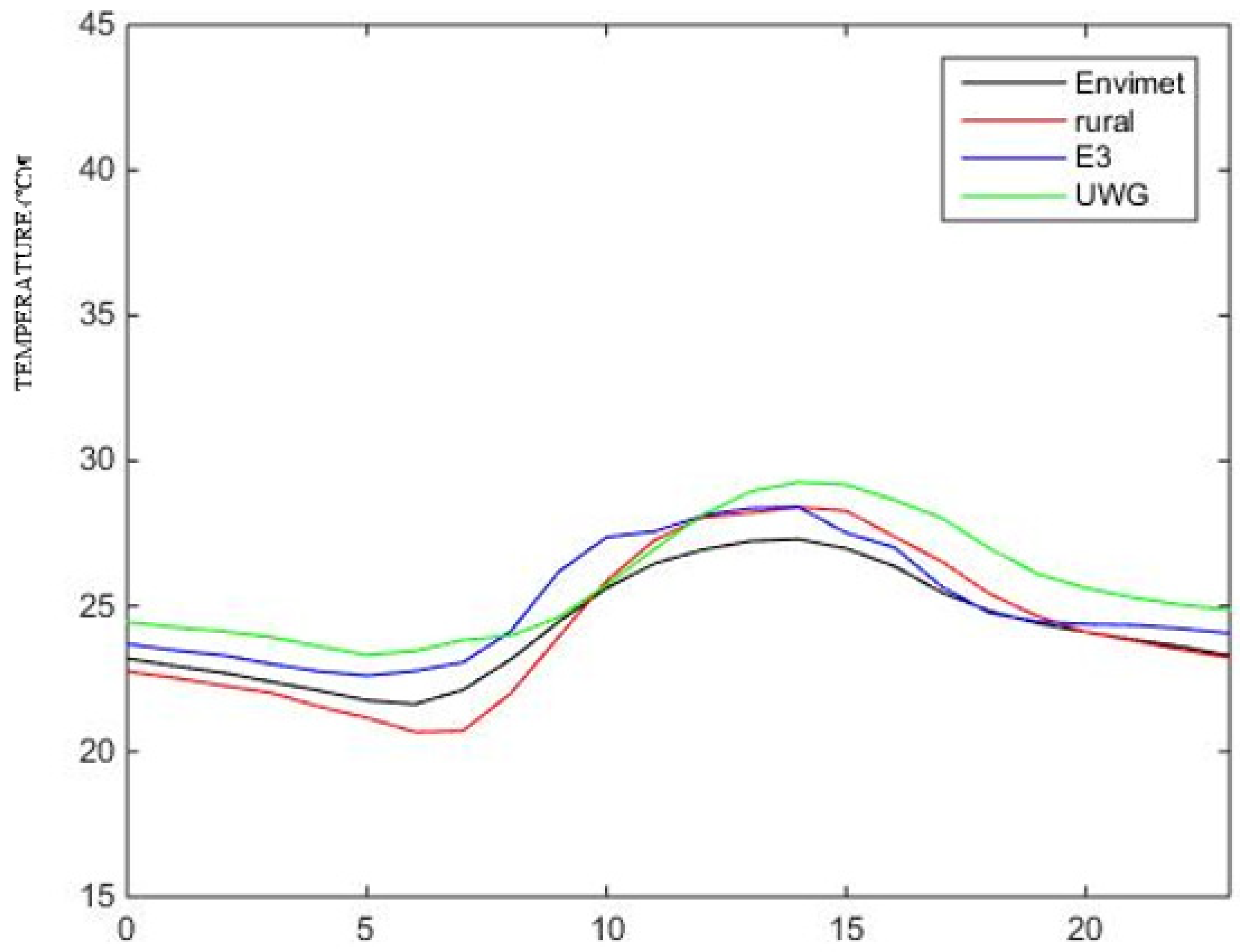
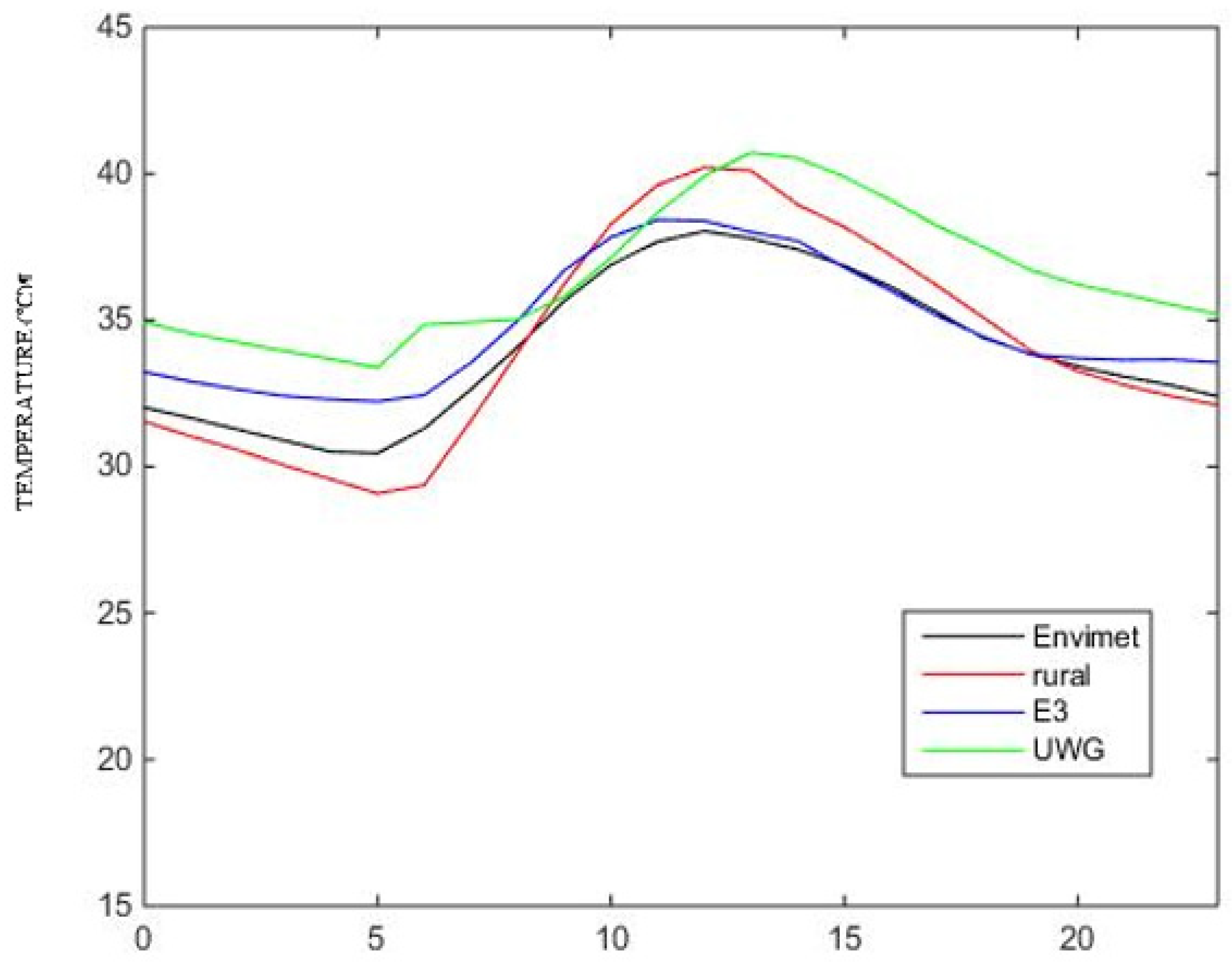
| Description (Areas in m2) | District E3 |
|---|---|
| Typology | Medium and High-rise Buildings |
| Number of buildings | 70 |
| Maximum number of floors | 20 |
| Minimum number of floors | 5 |
| Maximum border dimensions | 582 × 331 |
| Total area | 193,819.0 |
| Building area | 46,651.0 |
| Building area in % | 24.7 |
| Asphalt area | 93,992.0 |
| Asphalt area in % | 48.5 |
| Paved area | 53,176.00 |
| Paved area in % | 28 |
| Existing number of trees | 24 |
| Description | District E3 | |
|---|---|---|
| Typology | Medium and High-Rise Buildings | |
| Building use | Group 01 | Group 02 |
| Total Distribution | 38% | 34% |
| Glazing ratio | 0.5 | 0.25 |
| Window U-value | 2.4 W/m2 | 3.88 W/m2 |
| Cooling set point | 22 °C | 22 °C |
| Cooling COP | 2.5 | |
| Glazing ratio | 0.5 | |
| Cooling setpoint | 22 | |
| Building albedo (walls) | 0.5 | |
| Building emissivity (roof and walls) | 0.91 | |
| Description | District 3 |
|---|---|
| Non-Building Sensible Heat (W) | 11 |
| Non-Building Latent Heat (W) | 0 |
| Urban Road albedo | 0.165 |
| Urban Road emissivity | 0.95 |
| Distribution of the Building Typologies | |||||||
|---|---|---|---|---|---|---|---|
| Residential | Commercial | Offices | Restaurant | Hotel | Hospital | Common Areas | |
| Group 01 | 8.7 | 2.4 | 1.8 | 0.1 | 1.4 | 0 | 1.3 |
| Group 02 | 54.5 | 6.5 | 12.7 | 0.6 | 9.7 | 0.3 | 9.7 |
| Season | Scenario 01 | Scenario 02 | Scenario 03 | Scenario 04 | Scenario 05 | Scenario 06 |
|---|---|---|---|---|---|---|
| Autumn (2016) | Including the Anthropogenic Heat | Excluding the Anthropogenic Heat | Including only AH released from the AC | Including only the AH released from the cars | Including an increase in the vegetation | Including an increase in the shading devices |
| Size of the Model | Modified Materials | Boundary Conditions Changes | Post-Processing Activity |
|---|---|---|---|
| 180 × 180 cells | Soil profile | Irrigation profile | Air temperature 2 m |
| Pavement | Soil thickness | Air temperature 9 m | |
| Asphalt | Cloud distribution | ||
| Buildings wall |
| Winter 2016 (°C) | Spring 2017 (°C) | Summer 2017 (°C) | |
|---|---|---|---|
| UWG01 | 0.29 | −0.71 | −1.71 |
| UWG02 | 0.33 | −0.73 | −1.60 |
| UWG03 | 0.29 | −0.77 | −1.65 |
| UWG04 | 0.33 | −0.73 | −1.60 |
| UWG05 | 0.27 | −0.79 | −1.68 |
| UWG06 | 0.28 | −0.77 | −1.65 |
| Winter 2016 | Spring 2017 | Summer 2017 | |
|---|---|---|---|
| urban/UWG | 0.29 | −0.71 | −1.71 |
| urban/ENVI-met (no AH) | 2.04 | 0.23 | 0.79 |
| urban/ENVI-met (AH) | 1.51 | 0.76 | 0.26 |
| urban-rural | 1.99 | 0.71 | 0.59 |
| Winter 2016 | Spring 2016 | Summer 2017 | |
|---|---|---|---|
| RMSE (K) | |||
| ENVI-met (no AH) | 2.11 | 0.88 | 0.97 |
| ENVI-met (AH) | 1.63 | 0.50 | 0.62 |
| UWG (case01) | 0.89 | 1.19 | 2.06 |
| MBE (K) | |||
| ENVI-met (no AH) | 2.04 | 0.76 | 0.79 |
| ENVI-met (AH) | 1.53 | 0.23 | 0.26 |
| UWG (case01) | 0.29 | −0.71 | −1.71 |
© 2019 by the authors. Licensee MDPI, Basel, Switzerland. This article is an open access article distributed under the terms and conditions of the Creative Commons Attribution (CC BY) license (http://creativecommons.org/licenses/by/4.0/).
Share and Cite
Bande, L.; Afshari, A.; Al Masri, D.; Jha, M.; Norford, L.; Tsoupos, A.; Marpu, P.; Pasha, Y.; Armstrong, P. Validation of UWG and ENVI-Met Models in an Abu Dhabi District, Based on Site Measurements. Sustainability 2019, 11, 4378. https://doi.org/10.3390/su11164378
Bande L, Afshari A, Al Masri D, Jha M, Norford L, Tsoupos A, Marpu P, Pasha Y, Armstrong P. Validation of UWG and ENVI-Met Models in an Abu Dhabi District, Based on Site Measurements. Sustainability. 2019; 11(16):4378. https://doi.org/10.3390/su11164378
Chicago/Turabian StyleBande, Lindita, Afshin Afshari, Dina Al Masri, Mukesh Jha, Leslie Norford, Alexandros Tsoupos, Prashanth Marpu, Yosha Pasha, and Peter Armstrong. 2019. "Validation of UWG and ENVI-Met Models in an Abu Dhabi District, Based on Site Measurements" Sustainability 11, no. 16: 4378. https://doi.org/10.3390/su11164378
APA StyleBande, L., Afshari, A., Al Masri, D., Jha, M., Norford, L., Tsoupos, A., Marpu, P., Pasha, Y., & Armstrong, P. (2019). Validation of UWG and ENVI-Met Models in an Abu Dhabi District, Based on Site Measurements. Sustainability, 11(16), 4378. https://doi.org/10.3390/su11164378






